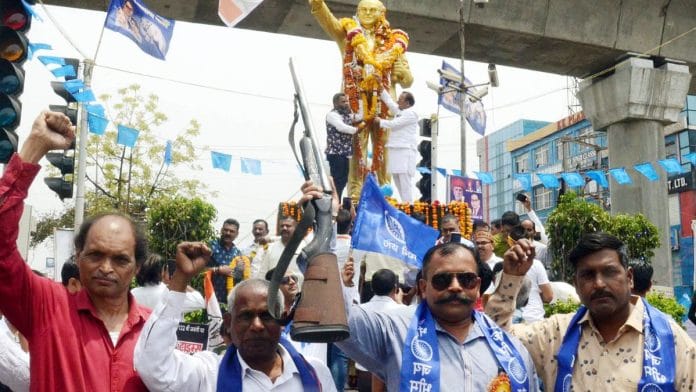Most of us have that one male cousin from a Tier 2 city who actively posts statuses on Whatsapp. In my cousin’s case, his WhatsApp status revolves mostly around deifying or showing utmost reverence to whoever is in vogue that day. Be it Jyotirao Phule, Shivaji or even a yesteryear prime minister. But from 1 April till 14—most of his status updates are about the grandeur, the glitz, the flashiness and the ostentatious scale of Ambedkar Jayanti celebrations; both past and future.
As a Dalit Buddhist, my family celebrates Ambedkar Jayanti every year. It’s a mini-Diwali for us. New clothes are bought, photos are garlanded and the year’s first aamras is made. The first homemade aamras of the season devoured with a lot of puranpolis is the highlight of the day. As a kid, April also meant summer holidays spent at my grandparents’ house. It’s where I’ve amassed most of my 14 April memories.
My grandparents lived in Manmad, a working-class town just under two hours from Nashik, Maharashtra. They had a big house and even bigger celebration on Ambedkar Jayanti. On the A-day, every kid of the house was woken up early and lined up for a bath. My uncles got a few extra minutes of sleep as they used to return late after garlanding the statue of Ambedkar in the town centre after a midnight ceremony. The outside of the bungalow was decorated at least two days in advance with different coloured twinkling lights—a novelty for us kids. The photos of Buddha and Ambedkar in the living room were already garlanded by the time we finished our baths.
And before bath time, there was music. The stereo, kept in the balcony, used to blare out devotional songs singing paeans to Ambedkar. Songs by Anand Shinde and Kadubai Kharat were played on loop. Some of the popular bhim geet were about how a sweeper can now dream of his son becoming a government officer, how Ambedkar deserves to be on currency notes, and about the emancipation of an entire social class and their late but new self-assuredness.
Also read: Indian media covers caste only when there’s a tragedy. X, Instagram, YouTube changed that
Jayanti turned into a dance party
14 April is the one day that Dalits own the streets. The folk songs which exulted the idea of taking to the same streets, which previous generations once cleaned, came true every Ambedkar Jayanti. These were never our streets. They were owned by the dandiya/garba players, the visarjan revellers, the dahi-handi crowd, the Holi groups—but on Ambedkar Jayanti every year these streets turned blue. The idea of replacing saffron with blue was a slightly militant but strong-willed gesture of independence.
This rebellious expression is now a thing of the past. Ambedkar Jayanti has now been diluted. It’s become the playground of political parties—their big ambitions translate to bigger banners.
What I have observed over the years is that Jayanti has been turned into a dance party of sorts, with the significance of it drowned out by the cacophony of loud music. I’m not saying celebration should not be a subjective experience, but let us not forget the objective truth while celebrating—that it has turned into a fiesta, a drunken revelry much like dahi-handi.
And the people who have made Ambedkar Jayanti into an all-night dance party, unfortunately, are the ones who have not even read a single book or essay by Ambedkar. It’s more like celebrating a saviour—which he was—without celebrating the ideas he espoused. One has to look beyond the figure and at his ideas as well if the ultimate goal is social and economic mobility.
Jayanti celebration has become so filmy, heroic and politicised that Ambedkar’s people are forgetting his ideals, views, principles and positioning him as a superhero instead. Apart from the usual “he wrote the Constitution”—aka Dalits’ Holy Book—rhetoric, the celebrations are so devoid of Ambedkar’s actual ideology that it has become indistinguishable from Hindutva road celebrations.
Also read: Bhakti to Babu Mangu Ram, where did anti-caste history go? Reduced to mere buzzwords
Another vote-seeking festival
Given the fragmented state of Dalit affairs, it’s no surprise that Jayanti has been appropriated by hardliner parties as a way to reach out to Bahujans and bring them into the greater Hindutva fold. To do this, they equate 14 April to the wider Hindu-centric celebrations of Shivaji Jayanti. Sure, Shivaji was a king from the OBC Maratha community (he was from the Kunbi caste), who became a revered symbol of Maratha pride. But positioning Shivaji as a messiah of the masses and as a parallel to Ambedkar, is essentially co-opting and robbing the agency of the Dalit movement.
This “we-are-in-this-together” approach from a politically strong Maratha faction does not bode well for present Dalit polity. It overlooks struggles of the marginalised castes, from the Dalit Panther days till today.
14 April has now turned into another vote-seeking festival and (based on my cousin’s WhatsApp statuses) a platform for power play. And with that, it has joined the ranks of every Indian festival where each community is competing on who makes the loudest noise and who’s the most jingoistic. I haven’t been to an Ambedkar Jayanti celebration for many years now. I miss the aamras, definitely, but it’s hard to tell if I miss the celebration or if it’s just childhood nostalgia. Just like it’s hard to understand Dalit politics today, where leaders like Ramdas Athawale, of Republican Party of India (A), are with the same forces that Ambedkar always fought against.
Vaibhav Wankhede is a creative marketer and writer. Views are personal. This article is part of Dalit History Month series.
(Edited by Theres Sudeep)






